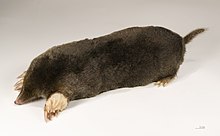Boreoeutheria
| Boreoeutheria Temporal range: Early Paleocene - Holocene, 65–0 Ma |
|
|---|---|
 |
|
| European mole (Talpa europaea) | |
| Scientific classification | |
| Kingdom: | Animalia |
| Phylum: | Chordata |
| Clade: | Synapsida |
| Class: | Mammalia |
| Clade: | Exafroplacentalia |
| Magnorder: | Boreoeutheria |
| Subgroups | |
Boreoeutheria (synonymous with Boreotheria) (Greek: βόρειο "north" + ευ "good" + θεριό "beast") is a clade (magnorder) of placental mammals that is composed of the sister taxa Laurasiatheria (most hoofed mammals, most pawed carnivores, and several other groups) and Euarchontoglires (Supraprimates). It is now well supported by DNA sequence analyses, as well as retrotransposon presence or absence data.
The earliest known fossils belonging to this group date to about 65 million years ago, shortly after the K-Pg extinction event, though molecular data suggest they may have originated earlier, during the Cretaceous period.
With the exception of rhinoceroses and cetaceans, male members of the clade share the distinction of external testicles.
The common ancestor of Boreoeutheria lived between 100 and 80 million years ago. The boreoeutherian ancestor gave rise to species as diverse as giraffe, dog, mouse, bat, whale and humans. The concept of boreoeutherian ancestor was first proposed in 2004 in the journal Genome Research. The genome sequence of the boreoeutherian ancestor can be computationally predicted with high accuracy. It is estimated to contain three billion base pairs.
Class Mammalia
The weakly favoured cladogram favours Boreoeuthearia as a basal Eutherian clade as sister to the Atlantogenata.
...
Wikipedia
